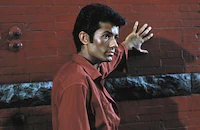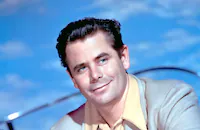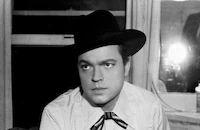Is Paris Burning?
Brief Synopsis
Cast & Crew
René Clément
Jean-paul Belmondo
Charles Boyer
Leslie Caron
Jean-pierre Cassel
George Chakiris
Film Details
Technical Specs

Synopsis
In August, 1944, as Allied troops await orders to march into German-occupied Paris, Hitler assigns command of the city to Gen. Dietrich von Choltitz. The Feuhrer's orders are simple and direct--if Paris cannot be held, it is to be burned to the ground. At the same time, the French Resistance movement, which has succeeded in taking possession of two-thirds of the city, is divided over a new plan of strategy. Gen. Jacques Chaban-Delmas, a Free French follower of Charles de Gaulle, strongly opposes those Communists favoring an immediate insurrection, which he fears might turn Paris into another Warsaw. With the help of the Swedish consul, Nordling, he attempts to arrange for the release of an important political prisoner, Bernard Labe, who might succeed in forestalling the uprising; but the plan ultimately fails, and Labe is shot. Word arrives that the Allies have decided to bypass the city and push directly to the Rhine, whereupon the Free French send Major Gallois to convince the Allied High Command that at least one military unit must liberate Paris, thereby enabling Germany to save face and surrender with honor. Von Choltitz, through all of this, procrastinates and ignores Hitler's hysterical demands that the city be burned. Largely responsible for the general's hesitancy is Nordling, who appeals to both von Choltitz' reason and his vanity by pointing out that by refusing to destroy centuries of history merely to satisfy a madman, he would become known as the man who saved Paris. Consequently, the order to burn the city is never given and, on August 25th, American and French soldiers liberate Paris. As von Choltitz is taken prisoner, exultant Parisians surge through the streets to greet the return of General Charles de Gaulle.

Director

René Clément
Cast

Jean-paul Belmondo

Charles Boyer

Leslie Caron
Jean-pierre Cassel

George Chakiris

Claude Dauphin

Alain Delon

Kirk Douglas

Glenn Ford
Gert Fröbe
Daniel Gélin

E. G. Marshall

Yves Montand

Anthony Perkins
Claude Rich

Simone Signoret

Robert Stack

Jean-louis Trintignant
Pierre Vaneck
Marie Versini
Skip Ward

Orson Welles
Bruno Crémer
Suzy Delair
Pierre Dux
Billy Frick
Harry Meyen
Hannes Messemer

Michel Piccoli
Sacha Pitoeff

Wolfgang Preiss
Michel Berger
Gehrard Borman
Georges Claisse
Germaine De France
Doc Ericson
Michel Etcheverry
Pascal Fardoulis
Bernard Fresson
Ernst Fritz Furbringer
Clara Gansard
Rol Gauffin
Georges Géret
Michel Gonzales
Konrad Georg
Claus Holm
Jean-pierre Honoré
Peter Jacob
Catherine Kamenka
Billy Kearns
Joëlle Latour
Michel Lonsdale
Roger Lumont
Maria Machado
Aimé De March
Félix Marten
Paloma Matta
Pierre Mirat
Harald Momm
Georges Montant
Russ Moro
Del Negro
Jean Negroni
Alain Pommier
Georges Poujouly
Michel Puterflam
Christian Rode
Serge Rousseau
Michel Sales
Wolfgang Saure
Georges Staquet
Otto Stern
Henia Suchar
Toni Taffin
Pierre Tamin
Jean Valmont
Jo Warfield
Joachim Westhoss
Jean-pierre Zola
Karl Otto Alberty
Albert Rémy
Joachim Hansen
Gunter Meisner
Helmut Schneider
Crew
Jean Aurenche
Yves Boisset
Pierre Bost
Claude Brulé
Aida Carange
Francis Ford Coppola
Louis Daquin
Michel Deruelle
Paul Graetz
Marcel Grignon
Willy Holt
Maurice Jarre
Robert Lawrence
Robert Macdonald
Beate Von Molo
Marcel Moussy
Pierre Nourry
Paramount Pictures
Antoine Petitjean
Paul Pollard
Seven Arts Productions
William Sivel
André Smagghe
Ray Stark
Jean Tournier
Gore Vidal
Roger Volper
Louis Wipf
Michel Wyn
Jean Zay

Film Details
Technical Specs

Award Nominations
Best Art Direction
Best Cinematography
Articles
Is Paris Burning?
The film was originally made in French, English and German (with each group speaking its own language). For the US release, the French sections of Is Paris Burning? were dubbed into English. Many of the actors (such as Leslie Caron and Charles Boyer) dubbed their own dialogue. The German sections were subtitled. The film itself was a genuine international effort and its cast reads like a who's who of world cinema. There's Orson Welles as Swedish consul Raoul Nordling, Anthony Perkins as a young sergeant and Leslie Caron as a wife searching for her captured husband. Kirk Douglas and Glenn Ford play key roles with Douglas as General Patton and Ford as General Bradley. Charles Boyer plays resistance leader Monod, Simone Signoret appears as a cafe owner and French heartthrobs Jean-Paul Belmondo and Alain Delon portray resistance fighters. And the entire picture revolves around General von Choltitz, played by Gert Frobe, the title villain from the James Bond adventure, Goldfinger (1964).
Is Paris Burning? was directed by Rene Clement, the French director best known for his Oscar®-winning Best Foreign Language film Forbidden Games in 1952. Based on a book of the same title by journalists Larry Collins and Dominique LaPierre, Is Paris Burning? was adapted for the screen by Francis Ford Coppola, Gore Vidal and others. Composer Maurice Jarre, who had previously won Oscars® for Lawrence of Arabia (1962) and Doctor Zhivago (1965) wrote the score.
Paul Graetz, the producer of Is Paris Burning?, deserves special credit for his painstaking attention to detail. For purposes of authenticity, he enlisted the help of the French army, various Parisian ministries and branches of the French government in every aspect of the production, from acquiring period military gear to shooting on actual locations. For example, the rail yard sequence where Welles and Caron go in search of a missing person was filmed in the actual location where many Parisians were shipped off to concentration camps; many of the extras used, in fact, had been living in Paris during the Nazi occupation. In the case where actual locations were not available, replicas were built and filmed at the French army base at Satory, near Versailles. Unfortunately, Graetz never got an opportunity to see the completed film; he died of a heart attack - possibly caused by the pressures of filmmaking - only a few weeks after production wrapped.
The film would be nominated for Best Art Direction and Best Cinematography. Its black-and-white photography evoked the quality of a newsreel, seamlessly integrating 1944 footage with new material shot in 1965. According to production notes, the decision to shoot in black-and-white was based partially on the French authorities' refusal to allow red and black Nazi flags to fly in Paris. Only black and gray flags were allowed for filming. Nevertheless, the appearance of extras in German uniforms was enough to cause a commotion. In one reported incident, a French postman fell off his bike, shouting "they're back!" when he spotted some 'soldiers' on lunch break.
Is Paris Burning? showcases the grandeur of Paris while establishing an underlying sense of urgency about the city's future. It contemplates a world with no Eiffel Tower, no Notre Dame, no Louvre. Hitler's orders were to destroy not only bridges and key military positions, but anything of value. In Is Paris Burning?, even General von Choltitz is moved by the futility of such destruction - realizing the war was lost and nothing could be gained by destroying one of the world's most beautiful cities. He signed a truce with the French Resistance forces on August 25, 1944 and surrendered the city. Von Choltitz was held in a US POW camp until 1947. He then returned to Germany where he died in 1966.
Producer: Paul Graetz
Director: Rene Clement
Screenplay: Larry Collins (book), Dominique LaPierre (book), Gore Vidal, Francis Ford Coppola, Marcel Moussy, Beate von Molo, Jean Aurenche, Pierre Bost, Claude Brule
Cinematography: Marcel Grignon
Film Editing: Robert Lawrence
Art Direction: Marc Frederix, Pierre Guffroy
Music: Maurice Jarre
Cast: Jean-Paul Belmondo (Pierreflot/Morandat), Charles Boyer (Docteur Monod), Gert Frobe (General Dietrich von Choltitz), Orson Welles (Consul Raoul Nordling), Leslie Caron (Francoise Labe), Jean-Pierre Cassel (Lieutenant Henri Karcher).
BW & C-173m. Letterboxed.
by Stephanie Thames

Is Paris Burning?
Robert Stack, 1919-2003
Stack was born in Los Angeles on January 13, 1919 to a well-to-do family but his parents divorced when he was a year old. At age three, he moved with his mother to Paris, where she studied singing. They returned to Los Angeles when he was seven, by then French was his native language and was not taught English until he started schooling.
Naturally athletic, Stack was still in high school when he became a national skeet-shooting champion and top-flight polo player. He soon was giving lessons on shooting to such top Hollywood luminaries as Clark Gable and Carol Lombard, and found himself on the polo field with some notable movie moguls like Darryl Zanuck and Walter Wanger.
Stack enrolled in the University of Southern California, where he took some drama courses, and was on the Polo team, but it wasn't long before some influential people in the film industry took notice of his classic good looks, and lithe physique. Soon, his Hollywood connections got him on a film set at Paramount, a screen test, and eventually, his first lead in a picture, opposite Deanna Durbin in First Love (1939). Although he was only 20, Stack's natural delivery and boyish charm made him a natural for the screen.
His range grew with some meatier parts in the next few years, especially noteworthy were his roles as the young Nazi sympathizer in Frank Borzage's chilling The Mortal Storm (1940), with James Stewart, and as the Polish flier who woos a married Carole Lombard in Ernst Lubitsch's To Be or Not to Be (1942).
After serving as a gunnery officer in the Navy during World War II, Stack returned to the screen, and found a few interesting roles over the next ten years: giving Elizabeth Taylor her first screen kiss in Robert Thorp's A Date With Judy (1948); the leading role as an American bullfighter in Budd Boetticher's The Bullfighter and the Lady (1951); and as a pilot in William Wellman's The High and the Mighty (1954), starring John Wayne. However, Stack saved his best dramatic performances for Douglas Sirk in two knockout films: as a self-destructive alcoholic in Douglas Sirk's Written on the Wind (1956), for which he received an Academy Award nomination for supporting actor; and sympathetically portraying a fallen World War I pilot ace who is forced to do barnstorming stunts for mere survival in Tarnished Angels (1958).
Despite proving his capabilities as a solid actor in these roles, front rank stardom oddly eluded Stack at this point. That all changed when Stack gave television a try. The result was the enormously popular series, The Untouchables (1959-63). This exciting crime show about the real-life Prohibition-era crime-fighter Eliot Ness and his G-men taking on the Chicago underworld was successful in its day for several reasons: its catchy theme music, florid violence (which caused quite a sensation in its day), taut narration by Walter Winchell, and of course, Stack's trademark staccato delivery and strong presence. It all proved so popular that the series ran for four years, earned an Emmy for Stack in 1960, and made him a household name.
Stack would return to television in the late '60s, with the The Name of the Game (1968-71), and a string of made-for-television movies throughout the '70s. His career perked up again when Steven Spielberg cast him in his big budget comedy 1941 (1979) as General Joe Stillwell. The film surprised many viewers as few realized Stack was willing to spoof his granite-faced stoicism, but it won him over many new fans, and his dead-pan intensity would be used to perfect comic effect the following year as Captain Rex Kramer (who can forget the sight of him beating up Hare Krishnas at the airport?) in David and Jerry Zucker's wonderful spoof of disaster flicks, Airplane! (1980).
Stack's activity would be sporadic throughout the remainder of his career, but he returned to television, as the host of enormously popular Unsolved Mysteries (1987-2002), and played himself in Lawrence Kasden's comedy-drama Mumford (1999). He is survived by his wife of 47 years, Rosemarie Bowe Stack, a former actress, and two children, Elizabeth and Charles, both of Los Angeles.
by Michael T. Toole
Robert Stack, 1919-2003
Quotes
Trivia
A French postman felt off his bicycle on the Champs Elysees, when he saw some extras dressed as German soldiers crossing the avenue during a lunch pause. He ran out screaming, "They're back! They're back!"
Some of the French actors, such as 'Charles Boyer' , Leslie Caron and Jean-Pierre Cassel, dubbed their own dialogue into English.
Notes
Copyright length: 136 min. Opened in Paris in October 1966 in 70mm under the title Paris brûle-t-il? Initial running time: 173 min. Subsequent cuts resulted in the omission of all of E. G. Marshall's scenes. Most sources credit only Gore Vidal and Francis Ford Coppola with screenplay.

Miscellaneous Notes
Released in United States Winter January 1, 1966
Partially shot in color and on 65mm film.
Released in United States Winter January 1, 1966













